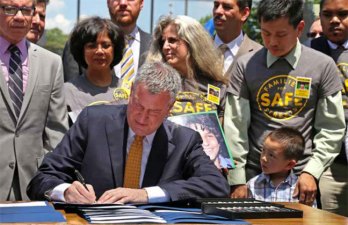City Council Proposes Vision Zero Funding Increase — Will de Blasio Agree?
The City Council is proposing a significant increase in funding for street safety projects. Now it’s up to Mayor de Blasio to decide whether to devote more resources to get the city closer to his Vision Zero goal of eliminating traffic deaths by 2024.

The council’s budget proposal calls for an additional $52.4 million in FY 2017 to complete 98 “operational” projects — low-cost improvements that can be built quickly with paint, plastic posts, and light construction work. That would be a nearly 25 percent increase from the 80 operational projects DOT completed in 2015.
The council also wants to allocate $250 million annually to more time- and resource-intensive Vision Zero capital projects. This would represent a big increase and match the funding level called for in Transportation Alternatives’ Vision Zero Investment Report. (Current annual spending on these projects is a little fuzzy, but the de Blasio administration set aside a total of $240 million for street safety capital projects over 10 years, then added $115 million for the next four years in its 2017 budget proposal.)
The de Blasio administration has reduced traffic deaths each of the past two years. With fatalities rising the first two months of this year compared to 2015, however, the city is not on track to maintain that progress. Transportation Commissioner Polly Trottenberg told the council earlier this month that her agency has the resources it needs, but it’s plain that DOT’s Vision Zero budget would benefit from a significant boost if the city is going to attain its street safety goals.
Transportation Alternatives staff and volunteers had a sit-down with council members a few weeks ago to discuss what it would take for the budget to align with the city’s Vision Zero goals. Yesterday the council released its response to the mayor’s preliminary FY 17 budget [PDF, page 42], and the council proposal is “almost entirely in line” with what TA is seeking, according to TA policy and research manager Julia Kite.
“Frankly, we’ve found that we’re not on track to get to Vision Zero, even remotely close to 2024, unless the Department of Transportation is given the resources to greatly expand the number of projects it’s doing,” said Kite. “I think our message was strong and it came across well.”
In addition to the additional Vision Zero funding, the City Council wants a DOT commitment to install 15 miles of protected bike lanes annually, up from the current commitment of five miles per year.
De Blasio’s response to the council will come later this month.
“Our main message is that if we want to get to zero, we need to do more,” said Kite, “and expanding the DOT budget in these specific ways is probably our best shot at getting back on track.”
